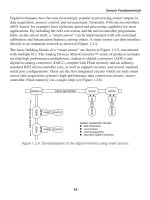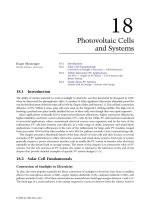PROJECT COMMUNICATION HANDBOOK 2007 pptx
Bạn đang xem bản rút gọn của tài liệu. Xem và tải ngay bản đầy đủ của tài liệu tại đây (887.29 KB, 48 trang )
PROJECT
COMMUNICATION
HANDBOOK
Second Edition
September 2007
Office of Project Management Process Improvement
Office of Project Management Process Improvement
1120 N Street, Mail Station 28
Sacramento, CA 95814
www.dot.ca.gov/hq/projmgmt
Project Communication Handbook
September, 2007
ii
Preface
Purpose
This document provides an overview of the basic concepts and processes
that guide project communication at the Department. The purpose of the
Project Communication Handbook is to assist the project team in identifying
internal and external stakeholders, developing the Project Communication
Plan, and enhancing communication among all parties involved.
Audience
All Department Capital Delivery Program personnel, including project
managers, their teams and supporting hierarchy.
Background
This is the 2
nd
edition of the Project Communication Handbook.
Revisions
This revision represents the original version of the 2
nd
edition.
Conventions
Titles of books and other documents appear in italics.
Web site URLs appear in bold italics.
Supplementary information appears in the left margin alongside normal
Like this example.
text in the right column.
Project Communication Handbook iii
iv
C
CONTENTS
Preface iii
Purpose iii
Audience iii
Background iii
Revisions iii
Conventions iii
Contents v
Figures vii
Overview 1
What Is Project Communication? 2
What Is Project Communication Management? 4
Task Manager Role in Communication 4
Why Do We Do It? 5
Processes 7
Overview 8
Develop the Communication Plan 9
Gather Planning Inputs 10
Identify Stakeholders 10
Determine Stakeholder Needs 11
Project Communication Handbook
v
Contents
Identify Communication Methods and WBS Products 11
Prepare the Communication Plan Draft 12
Distribute the Communication Plan Draft 16
Incorporate Changes and Finalize the Communication Plan 17
Distribute Information 18
Involve the Community 19
Report Communication Performance 20
Maintain and Archive Project Records 21
Tools and Methods 23
Communication Tools 24
Project Fact Sheet 24
Filing Systems 24
Work Breakdown Structure 25
Resource Breakdown Structure 25
Project Charter 25
Organization Breakdown Structure (OBS) 25
Performance Reporting 25
Communication Methods 26
Useful Website References 27
Appendices 29
Appendix A: Sample Project Communication Plan, Stakeholder Analysis, and
Communication Matrix 30
Appendix B: Sample Conflict Management Plan 34
Glossary 35
Acronyms 37
Index 39
Project Communication Handbook vi
Contents Figures
Figures
Figure 1. Communicating WBS element 3
Figure 2. Communication plan flowchart 9
Figure 3. Conflict management flowchart 15
Figure 4. Sample communication plan 31
Figure 5. Sample stakeholder analysis 32
Figure 6. Sample communication matrix 33
Project Communication Handbook
vii
Contents
Project Communication Handbook viii
1
OVERVIEW
This chapter summarizes Department project communication by:
Defining “project communication” and “project communication
management”
Explaining the purpose and goals of project communication
management at the Department
Project Communication Handbook
1
Overview
What Is Project Communication?
For more
information about project
stakeholders, see the
Project Management
Handbook.
For more
information about task
managers, see the Project
Management Handbook.
Project communication is the exchange of project-specific information
with the emphasis on creating understanding between the sender and the
receiver. Effective communication is one of the most important factors
contributing to the success of a project.
The project team must provide timely and accurate information to all
stakeholders. Members of the project team prepare information in a variety
of ways to meet the needs of project stakeholders. Team members also
receive feedback from these stakeholders.
Project communication includes general communication between team
members but is more encompassing. It utilizes the Work Breakdown
Structure (WBS) for a framework, it is customer focused, it’s limited in time,
it is product focused with the end in mind, and it involves all levels of the
organization. For details about the WBS, see “
Work Breakdown Structure”
on page 25.
For each WBS element, there are:
Suppliers who provide inputs needed for the WBS element
Task managers who are responsible for delivering the WBS element
Customers who receive the products of the WBS element
Suppliers must communicate with the task managers, and the task
managers must communicate with suppliers and customers. The supplier is
often the task manager for an earlier deliverable in the project lifecycle; the
customer may be a task manager for a later deliverable. Good project
communication includes notifying the next task manager in the project
delivery chain about when to expect a deliverable. The supplier and
customer may also be the functional manager.
It is important to note that the communication should be reciprocal
between the task manager and supplier and the task manager and
customer, i.e., although communication is the responsibility of the task
manager, the customer/supplier should always validate expected
deliverable dates (see Figure 1).
Project Communication Handbook 2
Overview What Is Project Communication?
S UPPLIER
-Provides input-
Could be task manager of earlier deliverable
T ASK M ANAGER
-Delivers the WBS element-
C USTOMER
-Receives the product-
Could be task manager for later deliverable
Figure 1. Communicating WBS element
The project communication plan is a part of the overall project plan. It
builds on the project workplan, which shows:
What will be produced on the project — the deliverable including
the WBS
Who will produce it — the Cost Center
When will it be produced
For more information, see
“Prepare the Communication Plan Draft” on page12.
Project Communication Handbook
3
Overview
What Is Project Communication Management?
Task Manager
Role in
Communication
Project Communication Management is the knowledge area that employs
the processes required to ensure timely and appropriate generation,
collection, distribution, storage, retrieval and ultimate disposition of
project information.
1
Project Communication is the responsibility of everyone on the project
team. The project manager, however, is responsible to develop the Project
Communication Management Plan with the input from the task managers
and Project Development Team (PDT).
A task manager responsible for a deliverable needs to know why
the customer wants it, what features they want, how long it will
take, and how they want to receive it.
The task manager tells their customer exactly when to expect
the deliverable. If that deliverable is linked to a WBS element on
the critical path, it is even more important that task manager
informs their internal customer when the deliverable will
arrive. The recipient functional manager must have their staff
ready to start work immediately after it arrives.
The task manager must ensure that internal customers know
about any changes in the delivery date. This allows the
recipient functional manager to schedule their resources
accordingly. The task manager follows up with the customer of
each deliverable. The task is not complete merely because the
final product is delivered to the customer. The task manager
contacts the customer to confirm that the deliverable met
his/her needs and expectations. The task manager should enter
feedback that others might use in future projects into the
lessons learned database and into the Department’s guidance
and training materials.
1
PMBOK Guide –Third Edition, page 221
Project Communication Handbook 4
Overview What Is Project Communication Management?
Why Do We Do It?
The project communication management processes provides the critical links
among people and information that are necessary for successful
communications.
Project managers use project communication management to:
Develop a communication plan for the project
Distribute information via the methods that reach customers most
effectively
File data using the Project Development Uniform Filing System and
Construction Organization of Project Documents
Archive records in accordance with Department Records Retention
policies
Project Communication Handbook
5
Overview
Project Communication Handbook 6
2
PROCESSES
This chapter explains the various processes involved in Department project
communication.
Project Communication Handbook
7
Overview Processes
Overview
Understanding the communication process is the first step in
communication planning. Consider these five factors:
Who is involved in the communication process — the identified
stakeholders, such as Project Team Members, project management
and staff, customer management and staff, and external
stakeholders.
What is being communicated — the message; the information being
communicated.
When the information is communicated — weekly, monthly,
quarterly, as needed, or as identified.
How the information is distributed— in a meeting, a memorandum,
an email, a newsletter, a presentation, etc.
Who will provide the information being communicated.
For more
information about the
roles of the customers,
Deputy District Director
for Program and Project
Management
(DDDPPM), and
District Director, see the
Project Management
Handbook.
Project Communication Handbook 8
Processes Develop the Communication Plan
Develop the Communication Plan
Preparing the project communication plan assists the project team in
identifying internal and external stakeholders and enhances
communication among all parties involved in the project. The project
manager leads the project development team to prepare a communication
plan to ensure that an effective communication strategy is built into the
project delivery process. The plan is a framework and should be a living,
evolving document that can be revised when appropriate. The
communication plan is part of the project management plan. Figure 2
shows the steps in the development of the communication plan.
Determine Stakeholder
Needs
Identify Communication
Methods and WBS Products
Prepare Communication
Plan Draft
Distribute Communication
Plan Draft
Any Changes from
Stakeholders?
Incorporate
Changes
End Process
No
Yes
Finalize Project
Communication Plan
WBS Product
List
Project Charter
Gather Planning Inputs
Begin Process
Identify Stakeholders
Figure 2. Communication plan flowchart
Project Communication Handbook
9
Develop the Communication Plan Processes
Gather Planning
Inputs
Identify
Stakeholders
The project development team (PDT) develops a communication plan by
asking the following questions:
Who needs what information?
When do they need the information?
Who delivers the information?
How should the information be delivered?
While all projects share the need to communicate project information, the
specific information needs and the methods of distribution may vary
widely.
The PDT develops two inputs for the project communication planning
process:
WBS product list — a list of potential project products, based on the
workplan that includes all the elements of the WBS, and the sub-
products of the WBS.
Project charter — the record of the agreement between the sponsor
and the project manager on the key elements of a project. The project
charter lists the project manager, the project sponsor, and the PDT
(for further details about the project charter, see the Project
Management Handbook).
Project stakeholders have information and communication needs.
Identifying the information needs of the stakeholders and determining a
suitable means of meeting those needs are important factors for project
success.
The PDT must identify the stakeholders on a project, determine what their
needs and expectations are, and then manage and influence those
expectations to ensure a successful project.
The PDT brainstorms a list of stakeholders using the roles identified in the
Project Management Handbook, the RBS/OBS list of functional areas, and the
Innovation Checklists for project manager (see Project Management Directive
(PMD) 007R).
Project Communication Handbook 10
Processes Develop the Communication Plan
Determine
Stakeholder Needs
The key to successful
community involvement is
communicating with
external project
stakeholders early and
often.
For more
information about the
PDT, see the Project
Management Handbook
and the third edition of the
PMBOK Guide section
10.4, pages 221 and 235.
Identify
Communication
Methods and WBS
Products
As early as possible, the PDT assigns team members to contact local,
regional, state, and federal agencies that have even a minor stake in a
project. By working with these agencies from the earliest stages, the project
team reduces the chance of conflict at critical times.
For more information about external project stakeholders, see “Involve the
Community” on page 19.
Project team members and stakeholders use different communication
methods at particular times during the project lifecycle. For examples of
communication methods, see “
Communication Methods” on page 26.
The project team uses the WBS product list to identify the products that
may be needed on the project. The PDT identifies:
Who produces the product
Who receives the product
The method of product transmittal
This information is tied directly to WBS elements and sub-products
required for the project.
Project Communication Handbook
11
Develop the Communication Plan Processes
Prepare the
Communication
Plan Draft
For a stakeholders
analysis sample, see “Figure
5. Sample stakeholder
analysis” on page 32.
Templates for the
stakeholder analysis and
the communication
matrix are available on
the Internet at:
.
gov/hq/projmgmt/
guidance.htm
The project communication plan includes the information needed to
successfully manage project product deliverables.
The project communication plan includes the following (see Figure 4.
Sample communication plan on page 31):
Brief introduction and background — answers the question, “Why
do we need a project communication plan?”
A list of the project sponsor, project manager, PDT members, and
other key stakeholders.
Methods of communications to be used, including formal meetings
to be held (who, what, when, how).
Project reporting information — answers the question, “How will
project performance be collected and distributed to the internal and
external project stakeholders?”
Stakeholders analysis — includes internal stakeholders (name and
contact information) identified by Cost Center number and
function, and external stakeholders (name and contact information)
identified by agency or organization. The stakeholders analysis is
designed to help the PDT analyze internal and external stakeholder
needs by gathering the following information from each
stakeholder:
Goals for the project. What is each stakeholder’s desired outcome
for the project? The project manager should ensure at the start that
there is a consistent vision for the project.
Preferred methods of communication. Project team members will
use this information as a means to meet individual
communication needs. If the team cannot reasonably
communicate through each stakeholder’s preferred medium, the
team needs to negotiate a method to ensure that each stakeholder
receives and understands the project communication.
Preferred method for recognizing performance of the team, within
the constraints of what is achievable. The PDT uses this
information to plan appropriate celebrations at the completion of
each project component. For a list of possible rewards, see “
Decide
How to Acknowledge the Performance of the Team” on page 14.
12 Project Communication Handbook
Processes Develop the Communication Plan
For
communication matrix
sample, see Figure 6.
Sample communication
matrix on page 33.
Communication matrix — this tool is used to track project
performance by project component and WBS element. The WBS
product list is the input. It includes the WBS codes, WBS titles, sub-
products, and Uniform Filing System location numbers. The list also
indicates which sub-products should be filed in the Project History
File (PHF). To complete the communication matrix, the PDT
indicates if the sub-product is required, who produces it, who
receives it, the method of transmittal, and the date submitted.
The project manager assigns a team member to complete the draft project
communication plan for each appropriate project component:
Project Initiation Document (PID)
Permits and Environmental Studies
Plans, Specifications, and Estimates (PS&E)
Right of Way
Construction
Project Communication Handbook
13
Develop the Communication Plan Processes
Decide How to Acknowledge the Performance of the Team
Some forms of recognition that are achievable in California State service
are:
Gold and Silver Superior Accomplishment awards & Employee
Recognition Program Accomplishment awards
End-of-project phase team celebrations organized by the project
manager and sponsored by appropriate managers and project
stakeholders
Certificates, posters, and letters of appreciation from the District
Director, Deputy District Director, or other appropriate manger
Certificates and letters of appreciation from local agencies and other
external stakeholders
Excellence in Transportation awards presented by the Department
Tranny awards presented by the California Transportation
Foundation
Purcell, Roberts, and Moskowitz awards presented by the
Department
Excellence in Highway Design awards presented by the Federal
Highway Administration
Environmental Excellence awards presented by the Federal Highway
Administration
Public Affairs Skills awards presented by the Federal Highway
Administration
Other External Professional Awards such as Project of the Year
awards by the ASCE
Develop a Conflict Management Strategy
A good communication plan includes a conflict management strategy
which is designed to make issues between stakeholders more manageable.
Project managers minimize conflicts and resolve issues through constant
communication with the project sponsor(s), project team members, and
other project stakeholders. Project managers can use the sample strategy
that appears later in this section, or can develop a more specific strategy.
The project manager negotiates and/or mediates conflict resolution.
Project managers encourage project stakeholders to seek win-win solutions
to their problems when possible. Because the project manager discusses
and develops a conflict management strategy before the project begins,
issues are more manageable. The project manager documents in the project
record any decisions that utilize the conflict management strategy.
Figure 3 shows an overview of conflict management (also see Appendix B
for conflict management plan).
Project Communication Handbook 14
Processes Develop the Communication Plan
Plan Execute Control
Begin Conflict
Management Process
Obtain Project Information
Project Manager Drafts
Conflict Management Plan
Forward Draft to Key
Stakeholders for Input
Changes Based on
Input from
Stakeholders?
Incorporate
Changes into
Conflict
Management
Plan
Finalize Conflict
Management Plan
Review Conflict
Management Plan
Follow the Plan to
Resolve Issue or
Take Issue to Next
Level
Document
Meetings and
Results
File Conflict
Management
Issues/Results in
Project Records
(PDPM Uniform
Filing System)
Record Diary Entries on
All Project Issues and
Results
File Diary Entries
in Project Folder
Conflict Arises
Yes
No
End Conflict
Management Process
Close
Figure 3. Conflict management flowchart
Project Communication Handbook
15
Develop the Communication Plan Processes
Sample Conflict Management Strategy
The project manager and the project stakeholders meet and agree to
The project manager
attempt to resolve all conflicts at an individual level as much as possible.
prepares the conflict
Two (or more) parties with a dispute will meet and use the following
management strategy with
guidelines:
input from stakeholders.
Stakeholders use this
strategy to resolve issues at
any time during the project.
To resolve conflicts within the scope of the project:
Step Action
1
Acknowledge the conflict
2
Establish ground rules
3
Establish common ground and shared goals
4
Separate the problem from the people
5
Have the parties share collected data related to the conflict
6
Explore solutions, listing as many alternatives as possible
7
Evaluate solutions, looking for a win-win solution
8
Select the best solution
9
Share the solution with the project stakeholders
Distribute the
Communication
Plan Draft
For complete
definitions of task
managers and functional
managers, see the Project
Management Handbook.
If a conflict cannot be resolved at an individual level, the conflict may need
to be escalated by the project manager with the functional manager or the
Chief of Program/Project Management. (See Appendix B for timetable for
escalation process.)
Each time stakeholders meet to resolve a conflict, they record the following
information:
Issues
Meeting date and location
Attendees
Results of meeting
The project manager sends the draft project communication plan to the
project stakeholders for review and input. When reviewing the
communication matrix, functional managers ensure that a task manager is
assigned to each WBS elements listed in the functional managers’ area of
responsibility. The functional managers list all the assigned task managers
on the communication matrix and the stakeholder analysis.
Project Communication Handbook 16
Processes
Incorporate
Changes and
Finalize the
Communication
Plan
Develop the Communication Plan
The project manager or PDT members incorporate changes from the
project stakeholders into the project communication plan. The project
manager then distributes the final project communication plan to the
project team members. The project management support unit (PMSU) uses
the finalized project communication matrix to track the progress of project
deliverables. (For a sample of a completed project communication plan, see
“
Appendix A: Sample Project Communication Plan” on page 30.)
Project Communication Handbook
17









